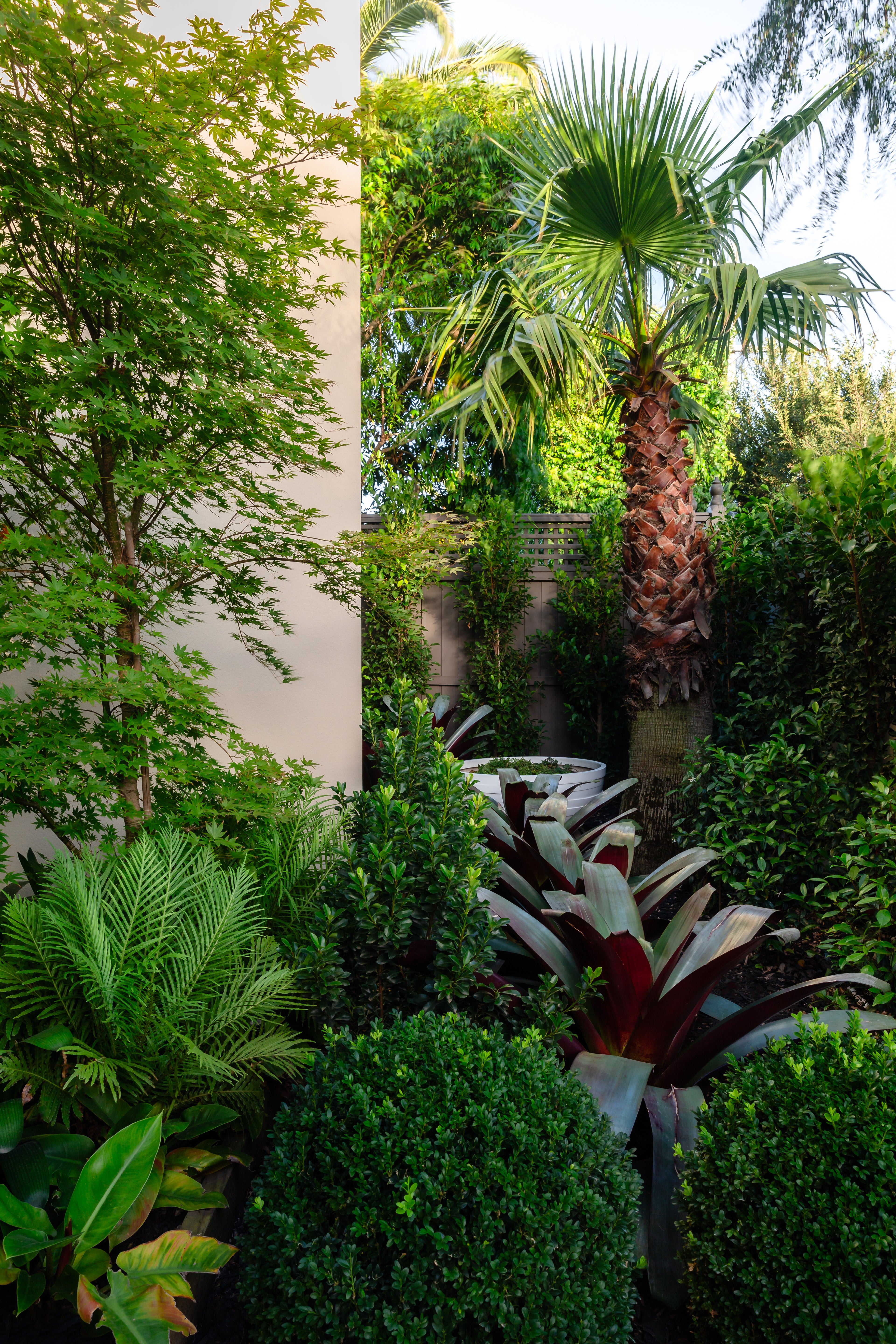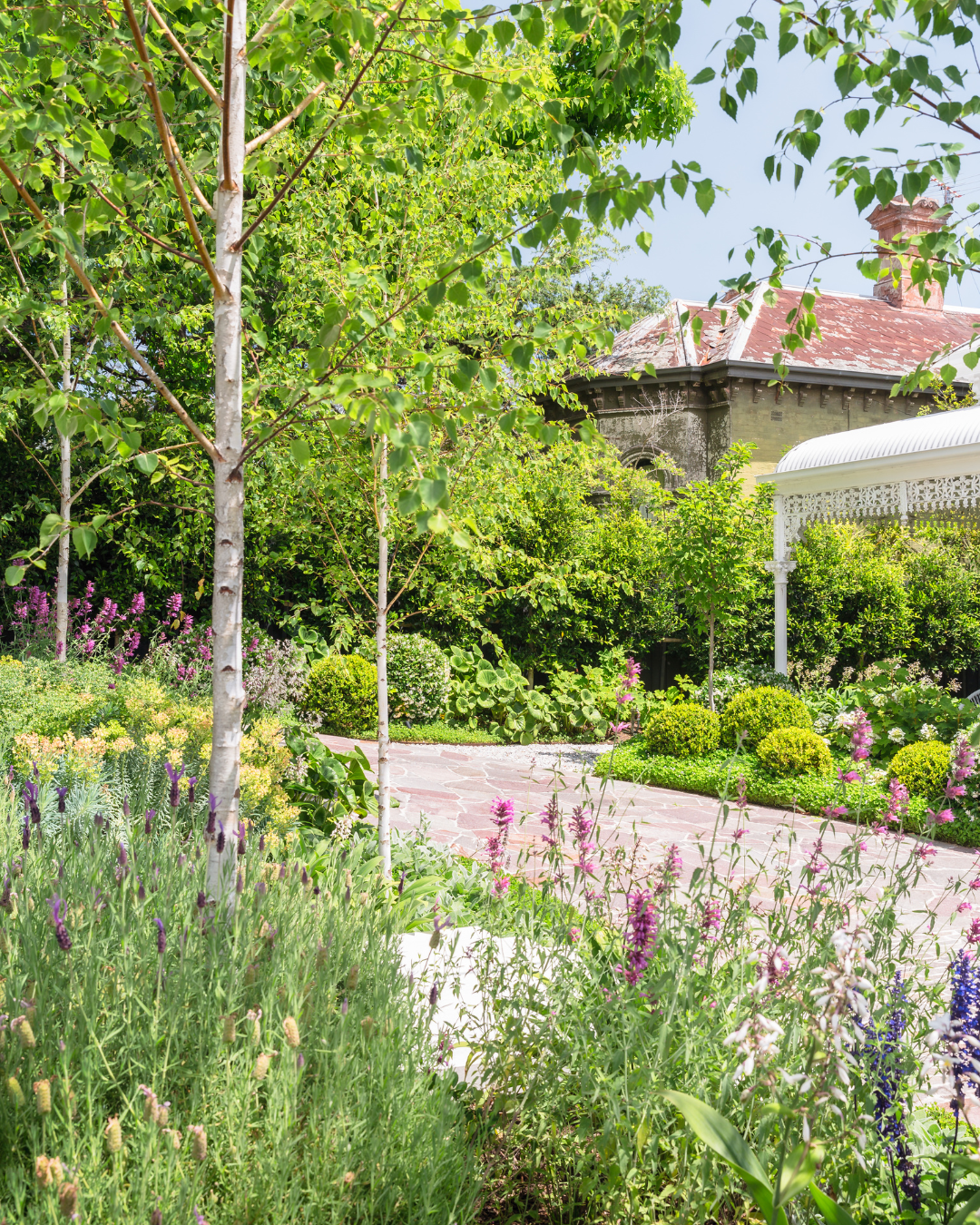Choosing the right trees is essential when creating a visually stunning and functional sloped garden. Beyond the aesthetic appeal, trees provide critical benefits for stabilizing soil, preventing erosion, and ensuring the long-term health of your garden. Sloped areas can present unique challenges like soil runoff and poor drainage. Still, with the right selection of trees, you can turn these challenges into opportunities for a thriving, vibrant garden. In this guide, we’ll explore three exceptional trees—Brachychiton populneus (Kurrajong), Acacia melanoxylon (Blackwood), and Banksia integrifolia (Coast Banksia)—that are ideal for sloped gardens, particularly for soil retention and providing stability.
The Importance of Trees in Sloped Gardens
Slopes can be tricky to manage, but they can become a garden’s standout feature with a strategic approach. Trees with deep, sturdy root systems are particularly valuable for sloped gardens because they help anchor the soil, reducing the risk of landslides or erosion. The right trees will enhance the garden’s beauty and provide functional benefits, ensuring your slope remains stable for years.
Key Factors to Consider When Choosing Trees for Sloped Gardens
- Root Structure: Trees with deep and wide-spreading root systems are essential for holding the soil in place on slopes.
- Water Requirements: Well-draining soil is critical for sloped gardens, so choose trees that tolerate various moisture levels.
- Size and Spread: Consider trees' mature height and width to ensure they fit within your garden design without overpowering the space.
Now, let’s dive into the top tree recommendations that can transform your sloped garden into a stable, thriving landscape.
Brachychiton populneus (Kurrajong)
Brachychiton populneus, commonly known as the Kurrajong, is a versatile and resilient tree perfect for sloped gardens. Native to Australia, this evergreen tree is well-adapted to dry conditions, making it an excellent choice for gardens with challenging landscapes. The Kurrajong is particularly noted for its ability to thrive in poor soils and withstand drought, which makes it ideal for stabilizing sloped areas.
Key Facts
- Mature Height: 10-20 meters
- Mature Width: 5-12 meters
- Best Uses: Feature tree, soil retention, windbreak
- Leaf Appearance: Glossy, dark green leaves with a unique lobed shape
- Rate of Growth: Moderate to fast
- Tolerates: Drought, poor soils, mild frost
Why It's Perfect for Your Garden
The Kurrajong's deep root system is one of its standout features, making it highly effective in preventing soil erosion on slopes. As it grows, its roots anchor the soil, helping to stabilize even the steepest slopes. Its glossy leaves add a lush, green aesthetic, ensuring your garden remains vibrant year-round. Additionally, Brachychiton populneus is relatively low maintenance and can tolerate harsh conditions, making it ideal for those seeking both functionality and beauty in their garden.
Acacia melanoxylon (Blackwood)
Acacia melanoxylon, or Blackwood, is another excellent choice for sloped gardens, particularly for its fast-growing nature and ability to stabilize soils. This evergreen tree is known for its dense foliage and elegant form, providing both shade and structural support to the garden. Blackwood thrives in various soil types, making it adaptable to different environments, including sloped areas where soil retention is a primary concern.
Key Facts
- Mature Height: 6-30 meters (depending on conditions)
- Mature Width: 4-10 meters
- Best Uses: Soil stabilization, shade, windbreak
- Leaf Appearance: Dark green, elongated leaves with a leathery texture
- Rate of Growth: Fast
- Tolerates: Frost, drought, poor soils
Why It's Perfect for Your Garden
The Acacia melanoxylon is not only fast-growing but also incredibly effective at stabilizing slopes due to its expansive root system. The tree’s roots grow deep and wide, ensuring maximum soil retention and reducing the risk of erosion. Its dense canopy provides ample shade, making it a great option for creating a cooler microclimate in your garden. The Blackwood is also highly tolerant of both drought and frost, making it a versatile choice for different climates and soil conditions. With its fast growth, you’ll quickly see the benefits of planting this beautiful tree in your sloped garden.
Banksia integrifolia (Coast Banksia)
Banksia integrifolia, also known as the Coast Banksia, is a robust tree that thrives in coastal and sloped environments alike. This tree is well-known for its attractive, serrated leaves and ability to withstand poor soils and salt-laden winds, making it a top choice for gardeners in sloped areas prone to erosion. With its iconic flower spikes, the Coast Banksia adds visual interest to your garden while contributing to soil stabilization.
Key Facts
- Mature Height: 10-25 meters
- Mature Width: 5-10 meters
- Best Uses: Soil retention, feature tree, erosion control
- Leaf Appearance: Long, leathery, green leaves with silver undersides
- Rate of Growth: Moderate to fast
- Tolerates: Salt, drought, poor soils
Why It's Perfect for Your Garden
One of the Banksia integrifolia’s key attributes is its extensive root system, which helps secure soil in sloped areas, reducing the risk of erosion. This tree is particularly suited to well-drained soils, making it a great choice for slopes where water runoff can be an issue. In addition to its functional benefits, the Coast Banksia produces stunning flowers that attract native birds, adding an extra layer of biodiversity to your garden. Its resilience in challenging conditions and visual appeal make it a standout option for sloped gardens.
Planting Tips for Sloped Gardens
Planting trees on a slope requires careful planning to ensure success. Here are some essential tips for planting your trees:
- Dig wide planting holes: Make the hole wider than deep to encourage the roots to spread horizontally, stabilizing the slope.
- Add organic matter: Incorporate compost or organic matter into the soil to improve drainage and support root growth.
- Terrace the slope: If possible, create small terraces or ledges on the slope to help slow water runoff and give trees a stable base.
- Mulch generously: Apply a thick layer of mulch around the base of the trees to help retain moisture and prevent soil erosion.
- Water strategically: Watering on a slope can be tricky. Be sure to water slowly to avoid runoff and allow water to penetrate deeply into the soil.
FAQs
-
What is the best time to plant trees on a slope?
The ideal time to plant trees on a slope is in early spring or autumn when moderate temperatures exist. This allows the tree to establish roots before extreme weather conditions. -
How do I prevent soil erosion when planting trees on a slope?
Choosing trees with deep root systems, adding mulch, and creating terraces can help reduce soil erosion. Planting ground cover alongside trees can also help hold the soil in place. -
How far apart should I plant trees on a slope?
The spacing depends on the species, but as a general rule, trees should be planted at least 3-5 meters apart to allow their root systems to develop fully without competing for nutrients.
Conclusion
Choosing the right trees for sloped gardens enhances the aesthetic appeal of your landscape and plays a crucial role in stabilizing the soil and preventing erosion. By selecting trees like Brachychiton populneus, Acacia melanoxylon, and Banksia integrifolia, you can ensure your garden remains vibrant, resilient, and thriving for years. These trees provide functional and visual benefits, making them perfect additions to any high-end garden looking for long-term stability and beauty.













